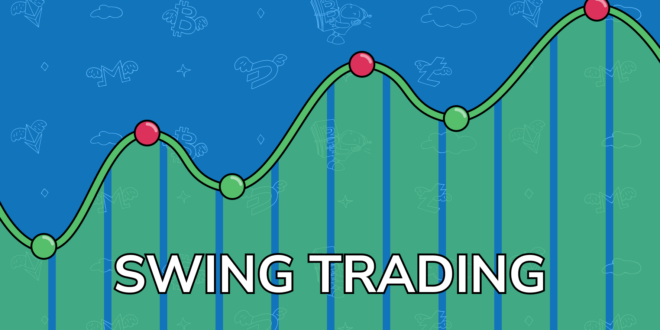In the world of finance, where fortunes are made and lost in the blink of an eye, swing trading stands out as a career path that offers both financial freedom and flexibility.
Swing trading stands as a beacon of financial opportunity, offering the promise of financial freedom and flexibility for those ready to navigate its intricacies. This trading strategy, nestled between day trading and long-term investing, capitalizes on short to medium-term market movements, granting traders the chance to harvest substantial gains without the daily grind or long-term commitment associated with other trading forms.
Despite its attractive proposition, success in swing trading is no fluke. It’s born from a comprehensive understanding of market patterns, robust risk management strategies, and a disciplined adherence to a well-crafted trading plan.
In the comprehensive post below, we explore the world of swing trading in-depth. From understanding its core principles and benefits like enhanced flexibility, effective risk management, and reduced emotional stress to delving into essential tools such as technical analysis and position sizing. We also highlight the challenges that potential swing traders may face, including market volatility and a significant learning curve, and offer insights into overcoming these obstacles.
By highlighting the path to financial freedom through swing trading, this guide equips you with the knowledge and strategies to embark on a successful trading journey. It emphasizes the importance of continuous learning, emotional resilience, and a dedicated time commitment to mastering the art of swing trading.
While the path may be fraught with challenges, for those committed to the journey, swing trading stands as a rewarding and liberating career choice.
While many aspire to make a living in the stock market, the complexities and risks associated with day trading and long-term investing can be daunting. However, swing trading provides an appealing middle ground that allows individuals to navigate the turbulent waters of the financial markets with greater ease and control.
What Is Swing Trading?

This is a trading strategy that falls between the realms of day trading and long-term investing. Unlike day traders who make multiple trades within a single day, and investors who typically hold stocks for months or even years, swing traders aim to capture short to medium-term price movements. They analyze charts, technical indicators, and market trends to identify potential entry and exit points, usually holding positions for several days to a few weeks.
The essence of swing trading lies in capitalizing on the natural price fluctuations that occur in the financial markets. Instead of trying to predict long-term trends or micro-managing daily price movements, swing traders focus on finding opportunities where they can “swing” into action and profit from a stock’s short-term price swings.
Why Swing Trading?
- Flexibility: One of the most attractive aspects of swing trading is the flexibility it offers. Swing traders aren’t tied to their screens all day, which means they can maintain a full-time job or pursue other interests while actively trading. This flexibility makes it an ideal career option for those who want to diversify their income streams or have time for personal pursuits.
- Risk Management: Swing trading allows for more effective risk management compared to day trading. Since positions are typically held for several days, swing traders can set stop-loss orders to limit potential losses. This provides a safety net and prevents catastrophic account blowouts that can occur in day trading.
- Reduced Emotional Stress: Emotions often play a detrimental role in trading decisions. Day traders are constantly exposed to rapid price fluctuations, which can lead to impulsive actions driven by fear or greed. Swing traders, on the other hand, have the luxury of stepping back and making well-thought-out decisions, reducing emotional stress.
Time to Learn and Adapt: Unlike day trading, swing trading allows beginners the time to learn and refine their strategies without being overwhelmed by the constant pressure of quick decision-making. This gradual learning curve can lead to more consistent and profitable results over time.
The Swing Trader’s Toolbox

To succeed in swing trading, individuals need to develop a comprehensive set of tools and strategies. Here are some key elements that every swing trader should consider:
- Technical Analysis: Swing traders rely heavily on technical analysis, using chart patterns, support and resistance levels, moving averages, and other indicators to identify potential entry and exit points.
- Risk Management: Effective risk management is paramount. Setting stop-loss orders and determining position sizes based on risk tolerance are essential practices for protecting capital.
- Trading Plan: A well-defined trading plan outlines a trader’s strategies, goals, and rules for entering and exiting trades. Sticking to a trading plan helps maintain discipline and consistency.
- Market Research: Staying informed about market news, economic events, and company-specific developments can help swing traders make informed decisions and avoid unexpected market shocks.
- Position Sizing: Determining the appropriate size of each trade is crucial for managing risk. Swing traders should avoid putting all their capital into a single position.
- Psychological Resilience: Developing emotional discipline is a vital aspect of swing trading. Learning to keep emotions in check and avoiding impulsive decisions is key to long-term success.
The Challenges of Swing Trading

While swing trading offers numerous advantages, it’s not without its challenges. Here are some common hurdles that swing traders may encounter:
- Market Volatility: Even though swing trading is less volatile than day trading, markets can still experience sudden price swings that may catch traders off guard. Managing these fluctuations requires vigilance and adaptability.
- Information Overload: Keeping up with market news and analysis can be overwhelming, especially for beginners. Developing the ability to filter relevant information from the noise is crucial.
- Learning Curve: Swing trading requires a learning curve, and success may not come overnight. Traders need patience and a commitment to continuous improvement.
- Capital Requirements: While swing trading doesn’t require as much capital as day trading, traders still need sufficient funds to effectively diversify their positions and manage risk.
- Time Commitment: Although swing trading is more flexible than day trading, it still requires time and dedication. Traders must allocate time for research, analysis, and trade execution.
The Path to Financial Freedom
Swing trading can indeed be the career that sets you free. With the right knowledge, tools, and mindset, individuals can enjoy the benefits of financial independence and flexibility that this trading style offers. However, it’s essential to remember that swing trading is not a guaranteed path to wealth. It requires discipline, dedication, and continuous learning.
For those willing to put in the effort and manage the inherent risks, swing trading can provide an avenue to build wealth, diversify income sources, and achieve financial freedom. It’s a journey that offers not only the potential for substantial financial rewards but also the opportunity to take control of one’s financial future on one’s terms.
So, if you’re looking for a career that combines financial success with personal freedom, swing trading may be the perfect fit for you.
Summary
Bottom line, swing trading stands as a compelling career choice that combines the best of both worlds in the financial landscape. It offers the potential for financial freedom and flexibility, allowing individuals to pursue their financial goals while maintaining control over their time and emotions.
While swing trading presents numerous advantages, it is not a quick path to riches, nor is it without its challenges. Traders must be prepared to invest time in learning, developing their strategies, and honing their emotional discipline. It’s a journey that demands dedication and a commitment to continuous improvement.
Yet, for those who embark on this journey with determination and a well-structured approach, the rewards can be substantial. Swing trading provides an opportunity to take control of one’s financial destiny, diversify income streams, and achieve a level of financial independence that few other careers can offer.
So, if you’re looking for a career that can set you free – both financially and personally – consider swing trading. It’s a path that, when navigated with diligence and care, can lead to a brighter, more self-determined financial future. Embrace the challenges, stay disciplined, and let swing trading open doors to financial success and a life with greater autonomy.
If you would like to discover more about the trading universe, keep on reading and learn about the safety and security of crypto trading and currencies.
 Imagup General Magazine 2024
Imagup General Magazine 2024



